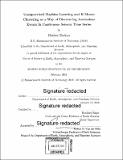| dc.contributor.advisor | Bradford Hager. | en_US |
| dc.contributor.author | Zhakiya, Elezhan | en_US |
| dc.contributor.other | Massachusetts Institute of Technology. Department of Earth, Atmospheric, and Planetary Sciences. | en_US |
| dc.date.accessioned | 2018-08-08T19:49:27Z | |
| dc.date.available | 2018-08-08T19:49:27Z | |
| dc.date.copyright | 2018 | en_US |
| dc.date.issued | 2018 | en_US |
| dc.identifier.uri | http://hdl.handle.net/1721.1/117323 | |
| dc.description | Thesis: S.M., Massachusetts Institute of Technology, Department of Earth, Atmospheric, and Planetary Sciences, 2018. | en_US |
| dc.description | Cataloged from PDF version of thesis. | en_US |
| dc.description | Includes bibliographical references (pages 51-52). | en_US |
| dc.description.abstract | Unsupervised k-Means clustering was implemented as a method for identifying anomalies in seismic time series. Sliding window approach was used for generating specific subsequences from the overall waveform. Dynamic Time Warping (DTW) was used as the method for comparing seismic subsequences. DTW barycenter averaging (DBA) was used as the method for averaging multiple subsequences within a group of similiar shapes. Clustering is able to discover anomalously shaped parts of a seismic time series in a completely unsupervised fashion, without requiring anyone to input actual times of the events, any predetermiend examples of events, or any other parameters about the signal. | en_US |
| dc.description.statementofresponsibility | by Elezhan Zhakiya. | en_US |
| dc.format.extent | 52 pages | en_US |
| dc.language.iso | eng | en_US |
| dc.publisher | Massachusetts Institute of Technology | en_US |
| dc.rights | MIT theses are protected by copyright. They may be viewed, downloaded, or printed from this source but further reproduction or distribution in any format is prohibited without written permission. | en_US |
| dc.rights.uri | http://dspace.mit.edu/handle/1721.1/7582 | en_US |
| dc.subject | Earth, Atmospheric, and Planetary Sciences. | en_US |
| dc.title | Unsupervised machine learning and k-Means clustering as a way of discovering anomalous events In continuous seismic time series | en_US |
| dc.type | Thesis | en_US |
| dc.description.degree | S.M. | en_US |
| dc.contributor.department | Massachusetts Institute of Technology. Department of Earth, Atmospheric, and Planetary Sciences | |
| dc.identifier.oclc | 1046449728 | en_US |
